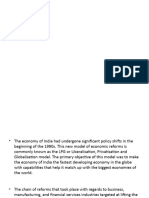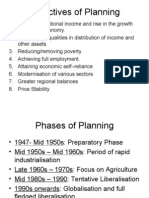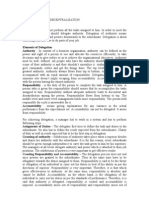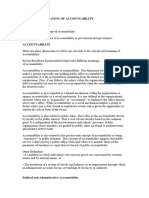0 ratings0% found this document useful (0 votes)
1 viewsLiberalization
Liberalization
Uploaded by
rotigop688Copyright:
© All Rights Reserved
Available Formats
Download as PPTX, PDF, TXT or read online from Scribd
Liberalization
Liberalization
Uploaded by
rotigop6880 ratings0% found this document useful (0 votes)
1 views8 pagesCopyright
© © All Rights Reserved
Available Formats
PPTX, PDF, TXT or read online from Scribd
Share this document
Did you find this document useful?
Is this content inappropriate?
Copyright:
© All Rights Reserved
Available Formats
Download as PPTX, PDF, TXT or read online from Scribd
Download as pptx, pdf, or txt
0 ratings0% found this document useful (0 votes)
1 views8 pagesLiberalization
Liberalization
Uploaded by
rotigop688Copyright:
© All Rights Reserved
Available Formats
Download as PPTX, PDF, TXT or read online from Scribd
Download as pptx, pdf, or txt
You are on page 1of 8
Liberalisation
Meaning of Liberalisation
• Liberalisation (or liberalization) is any method of how a state raises
limitations on some private individual ventures. Liberalisation befalls
when something which was forbidden is no longer forbidden or when
government laws are loosened.
• Liberalisation was begun to put an end to these limitations and open
multiple areas of the economy. Though some liberalisation proposals
were prefaced in the 1980s in areas of export-import policy, technology
up-gradation, fiscal policy and foreign investment, industrial licensing,
economic reform policies launched in 1991 were more general. There
are a few significant areas, namely, the financial sector, industrial
sector, foreign exchange markets, tax reforms and investment and trade
sectors which gained recognition in and after 1991
Liberalisation in India
• Since the adoption of the New economic strategy in 1991, there
has been a drastic change in the Indian economy. With the arrival
of liberalisation, the government has regulated the private sector
organisations to conduct business transactions with fewer
restrictions.
• For developing countries, liberalisation has opened economic
borders to foreign companies and investments. Earlier, Investors
has to encounter difficulties to enter countries with many
barriers.
• These barriers included tax laws, foreign investment restrictions,
accounting regulations, and legal issues. The economic
liberalisation reduced all these obstacles and waived few
restrictions over the control of the economy to the private sector
Objectives of Liberalisation
• To boost competition between domestic businesses
• To promote foreign trade and regulate imports and exports
• Improvement of technology and foreign capital
• To develop a global market of a country
• To reduce the debt burden of a country
• To unlock the economic potential of the country by encouraging the
private sector and multinational corporations to invest and expand.
• To encourage the private sector to take an active part in the
development process.
• To reduce the role of the public sector in future industrial development.
• To introduce more competition into the economy with the aim of
increasing efficiency.
Reforms under Liberalisation
• Deregulation of the Industrial Sector
• Financial Sector Reforms
• Tax Reforms
• Foreign Exchange Reforms
• Trade and Investment Policy Reforms
• External Sector Reforms
• Foreign Exchange Reforms
• Foreign Trade Policy Reforms
Impact of Liberalisation on Indian Economy
• Positive Impact of Liberalisation in India
• 1. Free flow of capital: Liberalisation has enhanced the flow of
capital by making it affordable for businesses to reach the
capital from investors and take a profitable project.
• 2. Diversity for Investors: The Investors will be benefitted by
investing a portion of their business into a diversifying asset
class.
• 3. Impact on Agriculture: In this area, the cropping designs
have experienced a huge change, but the impact of
liberalisation cannot be accurately measured. Government
restrictions and interventions can be seen from production to
distribution of the crop.
Impact of Liberalisation on Indian Economy
• Negative Impact of Liberalisation in India
• 1. The weakening of the economy: Enormous restoration of
political power and economic power will lead to weakening the
entire Indian economy.
• 2.Technological Impact: Fast development in technology allows
many small scale industries and other businesses in India to
either adjust to changes or shut their businesses.
• 3. Mergers and Acquisitions: Here small businesses are merging
with big companies, therefore, the small companies employees
may need to enhance their skilled and technologically advanced.
This enhancing of skill and the time it might take may lead to
non-productivity and can be a burden to the company’s capital.
THANK YOU
You might also like
- LPG Policy of India and Its EffectsDocument15 pagesLPG Policy of India and Its EffectsAsif100% (1)
- PSM 402 Liberalisation - Meaning, Impact, ObjectiveDocument3 pagesPSM 402 Liberalisation - Meaning, Impact, Objectiveny207814No ratings yet
- I B.Com A&F (Unit-1)Document12 pagesI B.Com A&F (Unit-1)shis01629No ratings yet
- Economics of Tourism 1ST UnitDocument25 pagesEconomics of Tourism 1ST UnitAbhishekNo ratings yet
- Economic ReformsDocument31 pagesEconomic ReformsDebashish Gorai100% (1)
- Indian Economic ReformsDocument22 pagesIndian Economic ReformsMradul BaghelNo ratings yet
- 4.2 Economic ReformsDocument29 pages4.2 Economic ReformsANITTA M. AntonyNo ratings yet
- LPG Policy of India and Its EffectsDocument18 pagesLPG Policy of India and Its EffectsFACTS YOU MISSED -हिंदीNo ratings yet
- LPG of Indian Business EnvironmentDocument38 pagesLPG of Indian Business EnvironmentSudhangsh KashyapNo ratings yet
- NEW ECONOMIC POLICY Minor Project BBA Banking and Insurance e Commerce College in MedDocument17 pagesNEW ECONOMIC POLICY Minor Project BBA Banking and Insurance e Commerce College in MedtanpreetjaggiNo ratings yet
- BE - Unit 3Document58 pagesBE - Unit 3Bell BottleNo ratings yet
- Liberalization of IndiaDocument18 pagesLiberalization of IndiaManjeet SinghNo ratings yet
- XII Economics - CH 3 - Liberalisation, Privatisation and Globalisation An AppaisalDocument9 pagesXII Economics - CH 3 - Liberalisation, Privatisation and Globalisation An AppaisalAayushi BishtNo ratings yet
- Unit 6 - LPGDocument20 pagesUnit 6 - LPGtempacc9322No ratings yet
- Development ProcessDocument5 pagesDevelopment Processsejalthakur701No ratings yet
- Impact of Liberalisation On Indian EconomyDocument17 pagesImpact of Liberalisation On Indian EconomyrulerhawkgamerNo ratings yet
- Lohita EcoDocument10 pagesLohita EcoAnmol SharmaNo ratings yet
- Lecture 2 LPGDocument36 pagesLecture 2 LPGSuram SrinivasNo ratings yet
- Planning and Economic Reforms in IndiaDocument18 pagesPlanning and Economic Reforms in IndiaProfessor Tarun Das50% (2)
- Efm PPT2Document4 pagesEfm PPT2rakhirakesh1286No ratings yet
- Unit 2 Economic Reform in IndiaDocument25 pagesUnit 2 Economic Reform in IndiaAvleen KaurNo ratings yet
- Liberalization, Privatisation and Globalisation!Document37 pagesLiberalization, Privatisation and Globalisation!Nivesh GuptaNo ratings yet
- Class 12 Economics 2023-24 Notes Chapter - 3 Liberalisation, Privatisation and Globalisation - RemovedDocument20 pagesClass 12 Economics 2023-24 Notes Chapter - 3 Liberalisation, Privatisation and Globalisation - RemovedDarshana BhansaliNo ratings yet
- Dr. Purvi Pujari: Liberalisation, Privatisation and GlobalisationDocument26 pagesDr. Purvi Pujari: Liberalisation, Privatisation and GlobalisationKalpita DhuriNo ratings yet
- New and Final EcooDocument81 pagesNew and Final EcoottNo ratings yet
- Economic Reforms and Implications For NepalDocument27 pagesEconomic Reforms and Implications For NepalSubarna k.C.No ratings yet
- The Main Features of New Economic PolicyDocument5 pagesThe Main Features of New Economic Policymaheswariavnagai2022No ratings yet
- LiberalisationDocument6 pagesLiberalisationkadamabariNo ratings yet
- LPG and India - 011656Document8 pagesLPG and India - 011656hcctygy979No ratings yet
- Chapter 3 - Global Trading EnvironmentDocument46 pagesChapter 3 - Global Trading Environmentkirthi nairNo ratings yet
- 1 Ch.8 - Structural Changes in Indian EconomyDocument39 pages1 Ch.8 - Structural Changes in Indian EconomyNazneen SiddiquiNo ratings yet
- Indian Economy in the Year of IndependenceDocument21 pagesIndian Economy in the Year of Independenceanjali.prakash969No ratings yet
- Chapter 2Document85 pagesChapter 2walterwhitef123No ratings yet
- 1991 Economic ReformsDocument5 pages1991 Economic Reformsvikassuryavanshi476No ratings yet
- Module 2Document60 pagesModule 2angelchakrabortyNo ratings yet
- Economic Reforms Since 1991Document26 pagesEconomic Reforms Since 1991Tanu BhatiNo ratings yet
- Liberalization, Globalization, PrivatizationDocument7 pagesLiberalization, Globalization, PrivatizationAmit RockNo ratings yet
- Liberalization in India - 1991: Slide 2 (Introduction)Document4 pagesLiberalization in India - 1991: Slide 2 (Introduction)Vidit AgrawalNo ratings yet
- Fesf PDFDocument32 pagesFesf PDFameeNo ratings yet
- Business Environment Unit 2 Note 5Document8 pagesBusiness Environment Unit 2 Note 5Sumit BainNo ratings yet
- Lecture 3 MGN 101Document32 pagesLecture 3 MGN 101Taukir SiddiqueNo ratings yet
- Class 11 Indian Economic Development Chapter 3 - Revision NotesDocument8 pagesClass 11 Indian Economic Development Chapter 3 - Revision NotesSuryash VaibhavNo ratings yet
- 23CME139Document10 pages23CME139speedgaming72567No ratings yet
- Industrial Policy1Document6 pagesIndustrial Policy1Prakash ReddyNo ratings yet
- Lib, Pri, GlobDocument39 pagesLib, Pri, GlobAjith NandanNo ratings yet
- Liberalization and GlobalizationDocument34 pagesLiberalization and Globalizationbadega2601No ratings yet
- DPSM Sem 6Document19 pagesDPSM Sem 6jainakshita591No ratings yet
- Recent TrendsDocument11 pagesRecent TrendsNandini MukherjeeNo ratings yet
- New Economic Policies, 1991Document102 pagesNew Economic Policies, 1991a.khurana15077No ratings yet
- Privatisation AND Globalisation LiberalisationDocument45 pagesPrivatisation AND Globalisation LiberalisationJanet AroraNo ratings yet
- IED CH 3 Revision NotesDocument9 pagesIED CH 3 Revision NotespriyankachhabraNo ratings yet
- FDI Policy in IndiaDocument9 pagesFDI Policy in IndiaRatnesh SinghNo ratings yet
- DPSM Question 1Document14 pagesDPSM Question 1Shipra ChaudharyNo ratings yet
- Deregulation, Liberalization and LPG Presentation - Ladio (Final)Document34 pagesDeregulation, Liberalization and LPG Presentation - Ladio (Final)Khemberly Randing LadioNo ratings yet
- BuluDocument20 pagesBulunarayanmeher07No ratings yet
- Chapter 3 - LPG PDFDocument45 pagesChapter 3 - LPG PDFkhushi SarafNo ratings yet
- SESSION-3 (New Economic Policy)Document6 pagesSESSION-3 (New Economic Policy)Chandan MallikNo ratings yet
- Class 12th Eco (Chapter 3 - LPG)Document7 pagesClass 12th Eco (Chapter 3 - LPG)Naushad AliNo ratings yet
- economic reformsDocument19 pageseconomic reformsutkarshpan222No ratings yet
- Business Success in India: A Complete Guide to Build a Successful Business Knot with Indian FirmsFrom EverandBusiness Success in India: A Complete Guide to Build a Successful Business Knot with Indian FirmsNo ratings yet
- Food Service Quality Management SystemDocument10 pagesFood Service Quality Management SystemJ CNo ratings yet
- Case Study 1Document15 pagesCase Study 1Gina MercadoNo ratings yet
- CAT-SBWIP-PMT-T-1938-2020 QCP - Installation of Cement-Based Non-Shrink Grout For Structural and Equipment GRDocument36 pagesCAT-SBWIP-PMT-T-1938-2020 QCP - Installation of Cement-Based Non-Shrink Grout For Structural and Equipment GRryann mananquilNo ratings yet
- Title: A Study On Opportunities and Challenges of E-Commerce Industry in IndiaDocument3 pagesTitle: A Study On Opportunities and Challenges of E-Commerce Industry in IndiaMs. Dhwani BhattNo ratings yet
- Presentation #: 01 (1 Hour) : Subject: Irrigation EngineeringDocument27 pagesPresentation #: 01 (1 Hour) : Subject: Irrigation Engineeringwajid malikNo ratings yet
- Annex C RR 11-2018Document2 pagesAnnex C RR 11-2018Maureen PascualNo ratings yet
- Prelim ReviewerDocument9 pagesPrelim Revieweraleksiyaah lexleyNo ratings yet
- Job Safety Analysis & Risk Assessment: Operating An Electric DrillDocument6 pagesJob Safety Analysis & Risk Assessment: Operating An Electric DrillH.J KENo ratings yet
- APPLICATION FORM For Delivery Channel ServicesDocument2 pagesAPPLICATION FORM For Delivery Channel ServicesAshish SharmaNo ratings yet
- p2 Guerrero Ch10 CompressDocument28 pagesp2 Guerrero Ch10 CompressLaiza Grace FabreNo ratings yet
- 2023-07-17 15.00.39 Transcript (English)Document18 pages2023-07-17 15.00.39 Transcript (English)MeidiyantoroNo ratings yet
- BEIS Branding TestDocument5 pagesBEIS Branding TestLilla KirályNo ratings yet
- FM Practical QuestionsDocument6 pagesFM Practical QuestionsLakshayNo ratings yet
- Illustration - gr11 - wk1 - Module1 LocalDocument12 pagesIllustration - gr11 - wk1 - Module1 LocalRaymond Michael A. GayatinNo ratings yet
- AIPIO WhitePaper 1-2019-LRwebDocument16 pagesAIPIO WhitePaper 1-2019-LRwebBrettpepplerNo ratings yet
- M/s HLL Infra Tech Services Ltd. (HITES) : Specific Conditions of Contract (SCC)Document21 pagesM/s HLL Infra Tech Services Ltd. (HITES) : Specific Conditions of Contract (SCC)Deepak ChandolaNo ratings yet
- Delegation & DecentralisationDocument4 pagesDelegation & DecentralisationKunal Maste50% (2)
- Blank Service Request FormDocument2 pagesBlank Service Request FormsandeepNo ratings yet
- Practical Financial Management 7th Edition Lasher Solutions Manual 1Document36 pagesPractical Financial Management 7th Edition Lasher Solutions Manual 1rebeccaterrelljefxwgzyod100% (44)
- Hadoop & Big DataDocument36 pagesHadoop & Big DataParesh BhatiaNo ratings yet
- HW 2Document3 pagesHW 2curveloNo ratings yet
- 0.1 BS 150 - Business ManagementDocument157 pages0.1 BS 150 - Business ManagementCourtney BilliouwNo ratings yet
- M8DZQXDocument2 pagesM8DZQXSALMAN PARVEZ ROKADIANo ratings yet
- Shsconf Icdeba2023 02022Document5 pagesShsconf Icdeba2023 02022engmohamedesmail2020No ratings yet
- Macroeconomics PrintDocument7 pagesMacroeconomics Printjoyce jabileNo ratings yet
- Concept and Meaning of AccountabilityDocument38 pagesConcept and Meaning of Accountabilitymesse524No ratings yet
- Insights From The Airbnb, NYC Analysis: For Lead Data Analyst & Data Analysis ManagerDocument12 pagesInsights From The Airbnb, NYC Analysis: For Lead Data Analyst & Data Analysis Managerdeerthika reddyNo ratings yet
- Intercape TicketDocument1 pageIntercape Ticketmanziagnes96No ratings yet
- Shashi BekalDocument6 pagesShashi BekalAdvocateNitinsharmaNo ratings yet
- Case Analysis About ResortDocument5 pagesCase Analysis About ResortMark NucupNo ratings yet

























































































